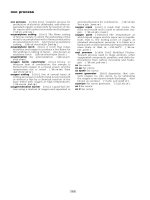Coatings Technology Handbook Episode 2 Part 7 potx
Bạn đang xem bản rút gọn của tài liệu. Xem và tải ngay bản đầy đủ của tài liệu tại đây (327.01 KB, 10 trang )
Fish Gelatin and Fish Glue
65
-3
be reduced to obtain a thickness of 0.10 mil (2.5
µ
m). Images of 10
µ
m wide or less are possible, and
these can be reproduced very accurately.
For very fine reticles on glass, silver wash-off emulsions can be made using fish gelatin. Silver chloride
is precipitated in diluted fish gelatin by the dropwise addition of silver nitrate and sodium chloride. Upon
completion, the emulsion is precipitated by the addition of 10% polystyrene sulfonate based on dry
gelatin weight and adjustment to a pH 4. This precipitates the emulsion, and the remaining liquid
containing dissolved salts is poured off. The emulsion is redissolved by neutralizing and sensitized by
the addition of ammonium bichromate or an organic sensitizer such as 4,4
′
-diazidostilbene-2,2
′−
disul-
fonic acid. Spin coating on glass will result in a 0.1 mil (2.5
µ
m) coating. After exposure to ultraviolet
light through a negative and washing, an image will appear on the glass. This image can be made black
by using a photographic developer such as Eastman Kodak Dectol.
65.3.4 Ceramic Stencils
Colored pigments can be ball milled into fish glue. These inks can be stamped or stenciled onto ceramic
parts and the resultant image fired to fix the pigment to the ceramic part.
65.3.5 Electrical Insulators
Fish gelatin, purified to have low ash, can be coated and then baked to reduce the water sensitivity. The
coating will have electrical insulating properties.
65.3.6 Temporary Protective Coatings
Because of their water solubility, fish gelatin coatings can be used as temporary protective coating on
metal parts during mechanical processing and handling. When complete, the parts are washed with a
dilute alkaline cleaner to provide a chemically clean and sterile surface.
65.3.7 Plating Release Agents
Fish gelatin is a liquid protein solution of high molecular weight that has a good attraction to clean metal
surfaces. When a clean metal plating master is dipped into a dilute solution, a monomolecular layer
attaches itself to the metal surface, which acts as a releasing agent after plating. After plating on the
master, the negative can be separated easily by starting at one edge and peeling the two pieces apart. The
master is then recleaned, dipped into the dilute gelatin solution, and replated.
65.3.8 Fish Gelatin in Photographic Coatings
Fish gelatin can be used in the silver halide emulsion system. Because fish gelatin solutions are liquid at
room temperature (down to 10
°
C), silver halides can be precipitated at temperatures less then required
for animal gelatin. The resultant emulsion can be washed of soluble salts by using any of the common
precipitating agents such as polystyrene sulfonate.
3
Photographic film usually requires a sublayer between the emulsion and the film to increase the
adhesion of the emulsion to the film. Photographic film also requires a back coating of gelatin to balance
the curling stresses of the emulsion coating. Fish gelatin can be used in both these applications.
65.3.9 Gelatin Capsules
Fish gelatin added to animal gelatin will reduce the softening point of animal gelatin capsules, and the
ature of the addition of fish gelatin to animal gelatin.
DK4036_book.fm Page 3 Monday, April 25, 2005 12:18 PM
© 2006 by Taylor & Francis Group, LLC
resultant capsules will dissolve more readily. Table 65.1 gives an example of the effect on gelling temper-
66
-1
66
Waxes
66.1 Introduction
66-
1
66.2 Definition
66-
1
66.3 Types
66-
2
66.4 Coating Applications
66-
4
References
66-
6
66.1 Introduction
A discussion on the use of waxes for coatings must begin with an explanation of what constitutes a wax.
Because of the diverse nature of products included in the class of waxes, this is not a simple objective.
There are few references that discuss waxes and their applications. In 1956 A.H. Warth published a
book that covered the types and applications of waxes available.
1
More recent general references on wax
are a two-volume work entitled
Industrial Waxes
by H. Bennett
2
and
Wax: An Introduction
by R. Sayers.
3
The Chemical Specialties Manufacturers Association (CSMA) has also published a booklet entitled
Technology of Waxes
, which contains several articles dealing with the chemistry and physical properties
of waxes of various types.
4
These are the major sources for information on waxes. Numerous articles are available, which may
discuss one specific type of wax or cover an application area, often only casually mentioning wax usage.
66.2 Definition
In the medieval days (and earlier) the definition of waxes was very simple. Wax was the substance
produced by bees that prevented the honey from running out the bottom of the hive. Beeswax was the
only wax known. In 1848 Justus Liebig characterized beeswax as consisting predominantly of long chain
fatty acids, esters, and alcohols. Several other natural waxlike products from plant and animal sources
had a similar chemical makeup. The definition of a wax was still fairly vague. If the chain length of a
substance was longer than the C
16
to C
18
associated with fatty acids, in a chemical sense, it was a wax.
In the 20th century, a large number of new products were introduced. Some of these were waxlike but
did not conform to the chemical definition. People wanting wax defined by physical properties won out
over those supporting a chemical definition. Therefore, products that have waxlike properties but are
not based on long chain esters (e.g., paraffins and low molecular weight polyethylenes) are referred to
today as waxes.
In 1954 the Deutsche Gesellschaft für Fettwissenschaft (DGF) established a wax definition based on
physical properties and abandoned the efforts to maintain the chemical definition. A revised version was
J. David Bower
Hoechst Celanese Corporation
DK4036_book.fm Page 1 Monday, April 25, 2005 12:18 PM
© 2006 by Taylor & Francis Group, LLC
Animal Waxes • Vegetable Sources • Mineral Waxes • Synthetic
Mechanism • Property Enhancement • Incorporation Methods
Waxe s
published in “DGF—Einheitsmethoden Abteilung M—Wachse” in 1975 (Table 66.1). The failure to put
67
-1
67
Carboxymethylcellulose
67.1 Introduction
67-
1
67.2 Coating Application
67-
1
67.3 Coating Formulation
67-
2
References
67-
4
67.1 Introduction
Carboxymethylcellulose (CMC) is a charged, water-soluble polysaccharide derived from cellulose found
in plants. It is used extensively in aqueous paper coatings for controlling coating viscosity. Aqueous paper
coatings are colloidal suspensions consisting primarily of pigment, such as kaolin clay, and binders such
as starch or latex. The solid concentrations typically range from 55 to 70%. The properties of a coating
are determined by colloidal forces acting between particles and by the properties of the suspending aqueous
phase. CMC affects the colloidal forces by adsorbing on clay pigment and by increasing the viscosity of
the aqueous phase. These effects will be discussed after a brief description of the coating process.
67.2 Coating Application
For the best performance in a paper blade coating machine, a coating should have a shear thinning
viscosity that decreases as the shear rate increases. Typical viscosities range from about 3000 mPa
⋅
s at
shear rates below 1000 sec
–1
when the coating is mixed and pumped to less than 100 mPa
⋅
s at shear rates
above 1,000,000 sec
–1
when the coating is applied to the paper. The linear velocity of paper in a coating
machine can vary from less than 450 m/min to greater than 1400 m/min.
Once the fluid coating has been applied to the moving paper web, the paper passes through a section
of the machine in which the excess coating is removed, often by a doctor blade. As the coating passes
under the doctor blade, the paper adsorbs water from the coating. The paper then goes to a dryer section,
where most of the water is removed to form a solid coating layer on the paper. If the coating’s water
phase viscosity is too low or if the coating particles form large aggregates with a porous structure, too
much water is lost prematurely from the coating under the blade. Solid aggregates form under the blade
and scratch the coated paper. Excessive water loss also raises the coating solids until the coating becomes
shear thickening (the viscosity increases with the shear rate). This causes undesirable streaking on the
paper. Shear thickening occurs as a result of increased collisions between the colloidal particles in the
coating. These collisions form aggregates that raise the viscosity. For good coating performance, it is
important to control the viscosity the water phase and to suppress the tendency of the solid particles to
aggregate upon collision. The viscosity of the water phase increases as the concentration of CMC
increases.
1
Particle aggregation is a direct consequence of the colloidal forces acting between the particles.
These forces and the role of CMC in affecting them are discussed next.
Richey M. Davis
Hercules Incorporated
DK4036_C067.fm Page 1 Thursday, May 12, 2005 9:51 AM
© 2006 by Taylor & Francis Group, LLC
Carboxymethylcellulose
67
-3
where
Φ
is the ratio of the solids volume and the total volume;
Φ
m
and
B
are dimensionless parameters
determined by fitting viscosity data to Equation 67.1.
An analysis of viscosity data using Equation 67.1 suggests that paper coatings, like other concentrated
suspensions, flow in ordered layers along streamlines rather like cards in a deck sliding over each other.
4
At low shear rates, this ordered structure results in a low viscosity. Above a critical shear rate, this ordered
structure breaks down and the particles in the suspension collide far more frequently, resulting in flow-
induced agglomeration and the resulting shear thickening viscosity is suppressed by treating the coating
with CMC.
FIGURE 67.2
Zeta potential of kaolin clay with adsorbed CMC at pH
=
7 and 25
°
C. [Adapted from R. M. Davis,
TAPPI J., 70
(5), 99 (May 1987), with permission.]
FIGURE 67.3
High shear viscosity for kaolin clay and CMC;
<
clay volume fraction
=
0.39. distilled water control:
0.10 part CMC/100 parts clay;
=
0.21 part CMC/100 parts clay; O 0.31 part CMC/100 parts clay. [Adapted from
R. M. Davis,
TAPPI J., 70
(5), 99 (May 1987), with permission.]
Zeta Potential, mV
36
32
28
26
22
20
34
30
24
0123456
Parts CMC/100 Parts Clay
Viscosity, mPa·s
50
45
35
25
20
40
30
1000 10,000 100,000
Shear Rate, 1/sec
DK4036_C067.fm Page 3 Thursday, May 12, 2005 9:51 AM
© 2006 by Taylor & Francis Group, LLC
68
-1
68
Hydroxyethylcellulose
68.1 Introduction
68-
1
68.2 Chemical Composition of Hydroxyethylcellulose
68-
2
68.3 Types and Grades of Hydroxyethylcellulose
68-
2
68.4 Chemical and Physical Properties of
Hydroxyethylcellulose
68-
3
68.5 Incorporating Hydroxyethylcellulose into Latex
Paints
68-
3
68.6 Application Properties of Latex Paints Thickened
with Hydroxyethylcellulose
68-
4
Reference
68-
5
68.1 Introduction
Hydroxyethylcellulose (HEC) is a nonionic, water-soluble polymer derived from cellulose. It is used in
water-borne paints for its action as a thickener, stabilizer, and/or suspending agent. HEC not only imparts
mechanical and chemical stability to the paint system, it plays a significant role in controlling the rheology
of the paint during manufacture, storage, and application. HEC is the most commonly used thickener
in latex paints. In fact, it is often referred to as the industry standard for thickening.
Physically, hydroxyethylcellulose is a white, free-flowing powder that dissolves readily in hot or cold
water. Available in a variety of types and grades, it can be used to produce aqueous solutions with a wide
range of viscosities and a pseudoplastic nature. Upon drying, solutions of HEC form clear, gel-free films.
The nonionic nature of HEC is an advantage in latex paints. Nonionics can be used over a wide pH
range and, unlike polyelectrolytes, are compatible with salts and charged species such as surfactants, latex
particles, and colorants.
More recently, a hydrophobically modified hydroxyethylcellulose (HMHEC) was introduced to the
latex paint industry.
1
HMHEC is an associative cellulosic polymer designed specifically for use in latex
paints. It is a nonionic water-soluble polymer that contains both hydroxyethyl and long chain alkyl
groups. This unique dual substitution differentiates the new-generation rheological modifier from tra-
ditional HEC. Like HEC, hydrophobically modified hydroxyethylcellulose thickens the aqueous phase of
the paint, but substantial viscosity is built through association of the polymer’s hydroprobes with the
paint components. HMHEC combines the desirable properties of HEC with the enhanced rheology
control (particularly with respect to spatter resistance and film build) required for today’s coatings. A
detailed discussion of HMHEC’s chemical composition and rheological performance in latex paints is
provided by Shaw and Leipold.
Lisa A. Burmeister
Aqualon Company
DK4036_book.fm Page 1 Monday, April 25, 2005 12:18 PM
© 2006 by Taylor & Francis Group, LLC
Leveling and Sag Resistance • Film Build • Spatter Resistance
69
-1
69
Antistatic and
Conductive Additives
69.1 Conductivity Additives for Spray Paints
69-
1
69.2 Antistatic Additives for Plastic Materials
69-
1
References
69-
3
69.1 Conductivity Additives for Spray Paints
In the electrostatic spray technique, the atomized paint particles receive a high voltage in the “gun.”
Paints formulated largely from nonpolar solvents have an electrical resistance that is far too high for
satisfactory application in this way. It is necessary to reduce the paint resistance below 1 M
Ω
, so very large
proportions of polar solvent would be necessary; therefore, a search for a more efficient chemical additive
Choosing the best quaternary ammonium compound involved the investigation of various chemical
structures, molecular weights, and anions. Using commercially available blends of raw materials and
avoiding potentially corrosive ions, it has been possible to develop a particularly effective product, namely
Catafor CA. Bearing in mind the customer preference for pourable liquids, an 80% solution in butanol
When using Catafor CA in paints, it is advantageous to add a modest amount of polar solvent, because
The advantages of using quaternary ammonium salts as a conductivity additive can be summarized
as follows:
1. Catafor CA, containing quaternary ammonium salts, is compatible with most types of paint, thus
avoiding reformulation.
2. The fluid 80% solution is quickly and easily dissolved.
3. Only low dosage is needed to produce a large drop in resistivity (0.5 to 3% in practice).
4. The same low dosage will reduce surface tension to a suitably low value.
5. Yellowing effects are not usually observed, even in sensitive white paints.
6. Effects on the paint film properties (evenness, general appearance, hardness, corrosion resistance,
etc.) are minimal.
69.2 Antistatic Additives for Plastic Materials
The many adverse effects of static electricity on insulating plastic materials are well recorded.
1,2
These
include textile processing difficulties, poor sound reproduction from records, excessive dust and dirt
B. Davis
ABM Chemicals Limited
DK4036_book.fm Page 1 Monday, April 25, 2005 12:18 PM
© 2006 by Taylor & Francis Group, LLC
a synergistic effect is usually observed (Table 69.1).
Subsequently, the paint particles are attracted to the grounded workpiece, resulting in highly efficient
paint utilization with good coverage of any awkward areas (Figure 69.1).
revealed that some quaternary ammonium compounds (Figure 69.2) are particularly effective alternatives.
is normally used to give very low resistivities with small additions, as illustrated with xylene in Figure 69.3.
70
-1
70
Silane Adhesion
Promoters
References
70-
3
Silane adhesion promoters are organofunctional silicon compounds that promote adhesion of coatings
to substrates, especially improving their resistance to debonding under humid conditions. It must be
emphasized that these silanes are not related to polydimethylsiloxane fluids, which cause cratering and
poor repaintability in coatings. Silane adhesion promoters may help overcome such problems of poor
wetting and intercoat adhesion in coatings.
Silane adhesion promoters are generally formulated into primers or added at relatively low levels to
coatings, in contrast to silicone resins, which are typically used at about 30% level in silicone-alkyd or
silicone-acrylic formulations. These silanes are ambifunctional compounds of the general structure
(CH
3
O)
3
Si–R–X, where X is an organofunctional group chosen for compatibility with the organic coating
and the alkoxysilane portion provides bonding to mineral substrates.
1
The alkoxysilane may be prehydrolyzed to silanols that are reactive with hydrate metal oxide surfaces
and contribute siloxane cross-links. Methoxysilanes also react directly with metal hydroxides and then
cross-link in the presence of atmospheric moisture.
Silane adhesion promoters are often effective in improving the adhesion of coatings to plastic surfaces
or to oily metal surfaces. As additives in paints, they may be useful in improving intercoat adhesion.
A recent trend is to formulate adhesion promoters by mixing silane monomers, partially prehydrolyzing
the silanes, or by mixing silanes with polymer precursors such as epoxies and melamines. Silane adhesion
promoters are offered by silane manufacturers Dow Corning Corporation, Union Carbide Corporation,
Petrarch Chemicals Division of Dynamit Nobel, and Peninsular Chemical Research, as well as by pro-
prietary formulators such as Hughson Chemical Division of Lord Corporation. Adhesion promoters
Walker
2
reviewed a study of silane primers and additives for adhesion of a two-part epoxy paint with
polyamide cure, and a two-part aliphatic isocyanate adduct cured polyester paint on mild steel, aluminum,
cadmium, copper, and zinc surfaces. Silanes were tested as primers (essentially monolayer coverage on
aluminum, indicate that the diamine-functional silane gave uniformly improved retention of adhesion
under wet conditions and gave greater recovery of adhesion when the panels were dried. Methacrylate-,
epoxy-, and mercaptofunctional silanes were also useful as adhesion promoters. Results were similar on
cadmium, copper, and zinc. Paints with some silane additives showed little deterioration in performance
during 9 months of storage.
Some general recommendations on use of silane adhesion promoters of Table 70.1 for coating on glass,
3
Edwin P. Plueddemann
Dow Corning Corporation
DK4036_book.fm Page 1 Monday, April 25, 2005 12:18 PM
© 2006 by Taylor & Francis Group, LLC
supplied by Dow Corning and recommended for coatings are described in Table 70.1.
metal), and as 0.1 to 0.4% additive based on total paint. Results, summarized in Table 70.2 for iron and
aluminum, and steel are summarized in Table 70.3.
71
-1
71
Chromium Complexes
71.1 Introduction
71-
1
71.2 Manufacture
71-
1
71.3 Methacrylic Acid Types
71-
1
71.4 End Uses
71-
2
71.5 Application Methods
71-
3
71.6 Governmental and Other Regulations
71-
4
71.1 Introduction
Chromium complexes are widely used for changing the characteristics of paper, glass, and other hydroxylic
surfaces, and the surfaces of materials such as polyethylene, which can be made functional by corona
discharge and similar methods. These binuclear compounds have the approximate formula shown in
in effect converted to –R groups. The radical R is of two general types: long chain saturated hydrocarbon,
incorporated by the use of a fatty acid, and unsaturated hydrocarbon, incorporated as methacrylic acid.
The fatty acids are used to change the physical properties of the surface, whereas the function of the
methacrylic acid is to change its chemical properties.
The chromium in these complexes is exclusively trivalent. As is discussed below, the health hazard
associated with hexavalent chromium compound is not present in these products, which have the approval
of the U.S. Food and Drug Administration (FDA).
71.2 Manufacture
The starting point for these materials is a solution of a basic chromium chloride, which is converted to
the complex by reaction with the appropriate acid. The products are green solutions, with such depth
of color that they appear black. In addition to being classed as flammable liquids, they are corrosive,
since some of the chlorine (see Figure 71.1) is hydrolyzed and therefore exists in the form of HCl. In
use, both hazards are removed by dilution and neutralization.
71.3 Methacrylic Acid Types
The du Pont Company makes methacrylatochromium complexes under the name Volan bonding agent.
Although the methacrylic acid types are used to coat substrates, the coating is always reacted further
before the end use is reached. They are therefore not normally considered to be coatings per se, and are
discussed only briefly.
A methacrylate group can polymerize with any other molecule undergoing vinyl polymerization. If
Volan-treated glass fiber, for instance, is impregnated with an unsaturated polyester, then when the latter
J. Rufford Harrison
E. I. du Pont de Nemours &
Company
DK4036_book.fm Page 1 Monday, April 25, 2005 12:18 PM
© 2006 by Taylor & Francis Group, LLC
Release • Water Resistance • Grease Resistance
Figure 71.1. The chromium end of the molecule attaches itself to the substrate, whose –OH groups are
72
-1
72
Nonmetallic Fatty
Chemicals as Internal
Mold Release Agents
in Polymers
72.1 Introduction
72-
1
72.2 Test Procedure
72-
2
72.3 Experimental
72-
2
72.4 Results
72-
3
72.5 Conclusions
72-
7
Acknowledgment
72-
7
72.1 Introduction
A major problem in injection molding is removal of the part from the mold. If the part has a large surface
area or a certain type of surface, it may be almost impossible to remove the piece without damage. The
force of the ejector can be increased to some extent, but this increases the possibility of damage to the
piece. The use of some type of mold treatment is well known in the industry. The most common treatment
is spraying a silicon- or fluorocarbon-type mold release agent directly on the mold. This procedure makes
it considerably easier to remove the piece from the mold, but unfortunately it causes other problems.
The spray-on mold release is typically good for eight to 10 moldings and then must be resprayed.
Continued respraying eventually causes a buildup on the mold, which must be removed. Both the
respraying and the cleaning cause an increase in cycle time.
The use of an internal mold release agent can eliminate or lessen the problems of spray-on mold
release. It would not be necessary to continually spray the mold, and there would not be as much buildup
on the mold when internal mold release agents are used.
One theory about how mold release additives work is that the additive exudes to the surface in the
time between injection and ejection and serves to lubricate the boundary area during ejection. The mold
release agent may also serve to reduce electrostatic attraction during ejection in some cases. If these
assumptions are true, then a number of things can affect the usefulness of an additive: solubility in the
resin, rate of migration in the resin, lubricity of the additive, melting point of the additive, and ability
of the additive to reduce electrostatic attraction, to name some. Since most of these interrelationships
are not well known, it follows that a large part of mold release is done on a trial-and-error basis. Eventually
what will and will not work can be predicted for a given resin, but these predictions are made only on
the basis of how similar compounds behave.
Kim S. Percell
Witco Corporation
Harry H. Tomlinson
Witco Corporation
Leonard E. Walp
Witco Corporation
DK4036_book.fm Page 1 Monday, April 25, 2005 12:18 PM
© 2006 by Taylor & Francis Group, LLC
Results • Polyolefins









